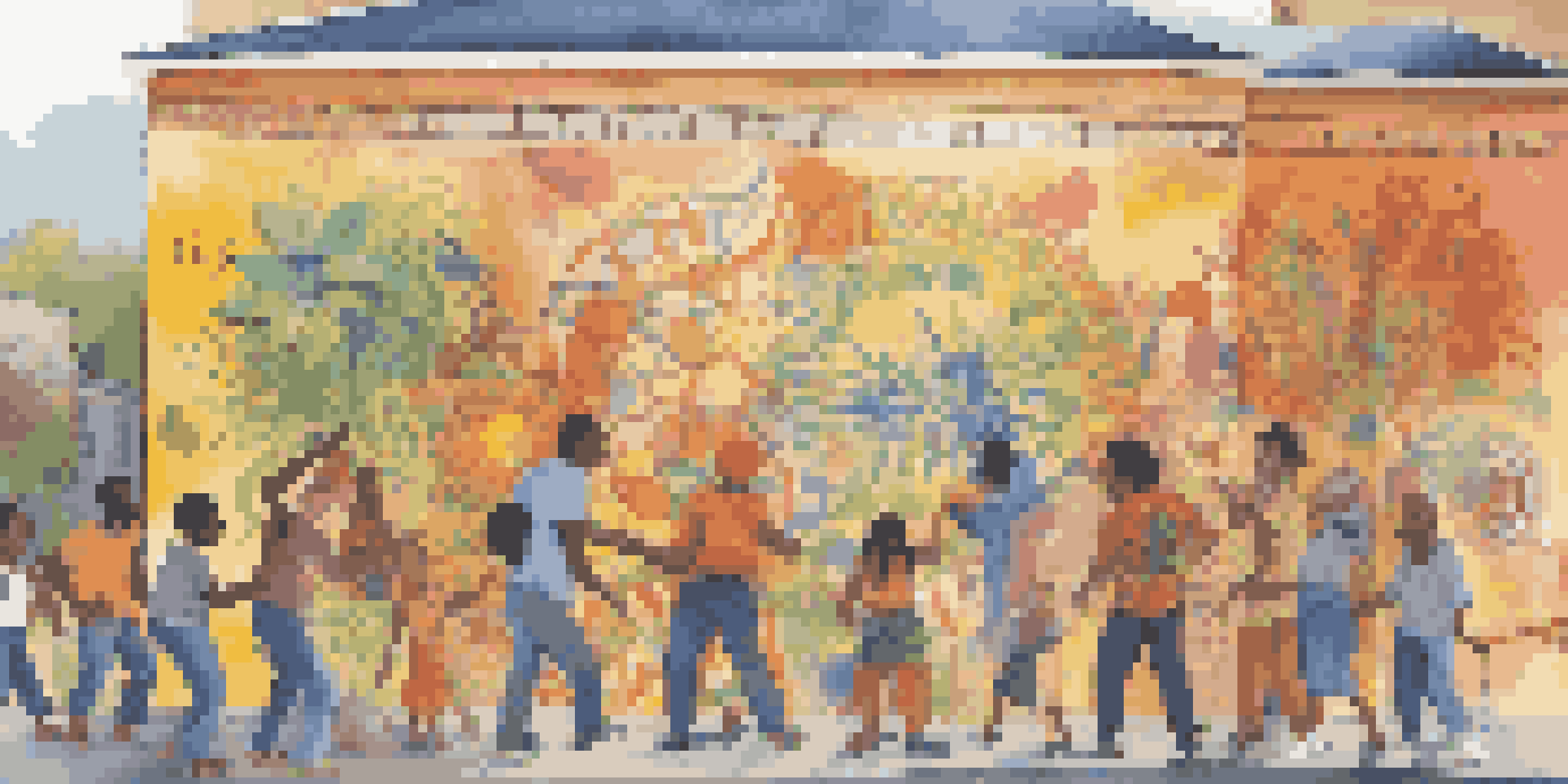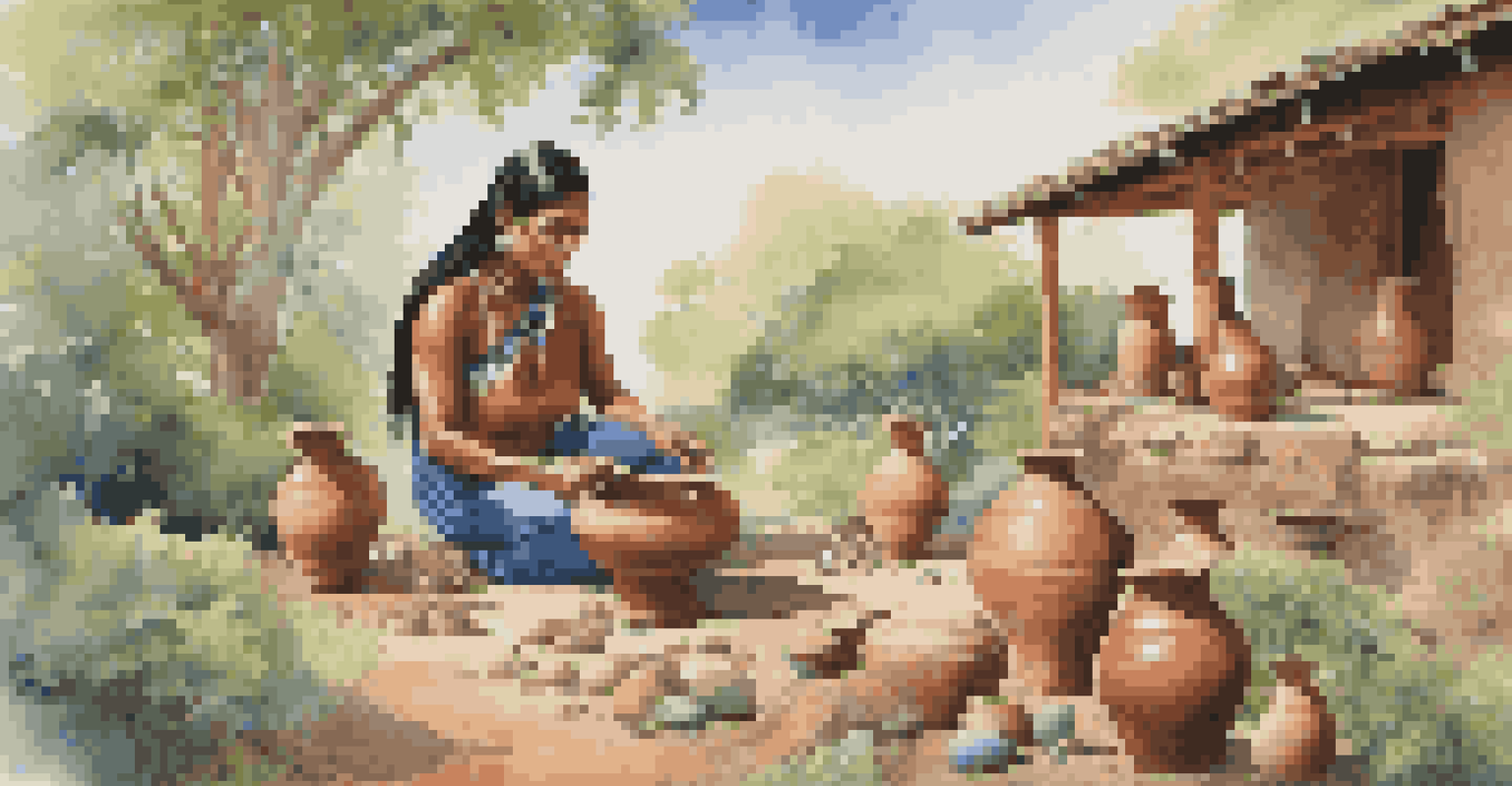The Use of Art in Conflict Resolution and Emotional Healing

Understanding Art as a Tool for Connection
Art has a unique ability to bridge gaps between individuals, creating a space for dialogue and understanding. Through various forms of expression, such as painting, music, or dance, people can share their feelings and perspectives in a way that transcends language barriers. This connection becomes especially valuable in conflict situations, where emotions often run high and communication can break down.
Art is not freedom from discipline, but disciplined freedom.
For instance, a community mural project can bring together individuals from different backgrounds, encouraging them to collaborate on a shared vision. This not only fosters a sense of belonging but also allows participants to express their individual experiences and emotions related to the conflict. Such projects demonstrate how art can facilitate conversations that might otherwise be difficult to initiate.
Ultimately, art acts as a catalyst for empathy, allowing people to see the world through another's eyes. By creating a shared experience, it can transform adversarial relationships into opportunities for understanding and cooperation.
The Healing Power of Creative Expression
Creative expression is not just a way to communicate; it is also a powerful means of healing. Engaging in artistic activities can provide individuals with a safe outlet to process their emotions and experiences, particularly in the aftermath of trauma. Whether it's writing poetry, painting, or playing an instrument, these activities can help individuals articulate feelings that may be too painful or complex to verbalize.

For example, a survivor of conflict may find solace in creating art that reflects their story. This process can be therapeutic, allowing them to confront their emotions and begin to heal from their experiences. Art therapy has been recognized for its effectiveness in helping individuals work through trauma and regain a sense of control over their lives.
Art Connects People and Cultures
Art serves as a bridge for dialogue and understanding, transcending language barriers to foster empathy among individuals from diverse backgrounds.
Moreover, the act of creating art can promote mindfulness, encouraging individuals to focus on the present moment. This shift in perspective can be incredibly healing, enabling them to let go of past pain and envision a more hopeful future.
Art as a Medium for Dialogue and Understanding
In conflict resolution, art serves as a powerful medium for dialogue. It allows individuals to express their thoughts and feelings creatively, fostering a more open and honest exchange of ideas. This can be particularly effective in settings where traditional communication methods have failed or where participants feel uncomfortable voicing their opinions.
The only way to make sense out of change is to plunge into it, move with it, and join the dance.
For instance, in workshops aimed at resolving community disputes, participants might be invited to create visual art that represents their perspectives. Sharing these pieces can spark conversations that lead to deeper understanding and potential solutions. This approach helps to break down barriers and build trust among conflicting parties.
Art encourages participants to listen actively and engage with one another's narratives. By focusing on the art itself rather than the conflict, individuals can find common ground and work together toward resolution.
Case Studies: Successful Art-Based Interventions
Numerous organizations around the world have successfully employed art in conflict resolution efforts. For instance, in post-apartheid South Africa, initiatives like the 'Apartheid Museum' used art and storytelling to facilitate discussions about the past and promote reconciliation. These projects helped communities process their collective trauma and move forward together.
Another example can be found in the 'Kaleidoscope Project,' which engages youth from conflicting communities through creative workshops. By collaborating on artistic projects, participants learn valuable skills in communication and teamwork, paving the way for improved relationships and reduced tension between groups.
Creative Expression Heals Trauma
Engaging in artistic activities provides a safe outlet for individuals to process emotions, particularly in the aftermath of trauma.
These case studies highlight the versatility of art as a tool for resolving conflicts. By fostering understanding and empathy, art can play a crucial role in healing and rebuilding fractured communities.
The Role of Art Therapy in Emotional Healing
Art therapy is a specialized form of therapy that combines traditional psychological practices with creative expression. It provides individuals with the opportunity to explore their emotions and thoughts in a supportive environment, often leading to significant breakthroughs in emotional healing. Therapists guide participants in using various artistic mediums to express themselves, making it easier to address difficult feelings.
Research has shown that art therapy can be particularly effective for individuals dealing with trauma, anxiety, or depression. The creative process allows them to externalize their feelings, which can reduce the intensity of those emotions and promote healing. As they create, participants often gain insights into their experiences and develop coping strategies.
Ultimately, art therapy not only fosters emotional healing but also empowers individuals to take charge of their mental health. By engaging with their creativity, they can discover new facets of themselves and build resilience in the face of challenges.
Art as a Means of Cultural Preservation
Art plays a crucial role in preserving cultural identities, especially in communities affected by conflict. Through storytelling, music, and visual arts, individuals can document their history, traditions, and experiences, ensuring that their narratives are not lost. This cultural preservation becomes even more vital in times of strife, as it helps maintain a sense of belonging and continuity.
For example, indigenous communities often use art to express their heritage and resist cultural erasure. By creating traditional crafts, songs, and dances, they not only celebrate their identity but also educate others about their history and values. This cultural expression fosters pride and unity within the community while opening up dialogues with outsiders.
Art Preserves Cultural Identities
Through various forms of expression, art helps document and celebrate cultural histories, ensuring that marginalized voices are heard and valued.
In this way, art becomes a powerful tool for social change, allowing marginalized voices to be heard and valued. As these narratives are shared, they can contribute to broader conversations about justice, equity, and healing.
Future Directions: Integrating Art in Conflict Resolution
Looking ahead, the integration of art in conflict resolution processes is likely to grow. As more individuals and organizations recognize the transformative power of creative expression, we can expect to see innovative programs that leverage art for healing and dialogue. This may include workshops, community projects, and even digital platforms that facilitate artistic collaboration across borders.
Additionally, as society becomes increasingly aware of mental health's importance, the demand for art therapy and similar approaches will likely rise. This shift could lead to more funding and support for art-based initiatives in conflict zones and areas affected by trauma, ensuring that those in need have access to these healing resources.

Ultimately, the future of conflict resolution may be shaped significantly by art's unique ability to foster connection, understanding, and healing. By embracing creativity as a tool for change, we can work together to build a more peaceful and compassionate world.